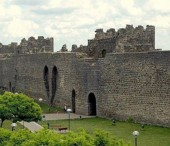Edirne (see also its other names) is a city in Thrace, the westernmost part of Turkey, close to the borders with Greece and Bulgaria. It is the capital of Edirne Province (Turkish Thrace) and its estimated population in 2002 was 128,400, up from 119,298 in 2000.
Name
The city was known in English until after the First World War as Adrianople (see below).
The city initially took its Greek name of Hadrianopolis after its Roman (re)founder, Emperor Hadrian, and the usage remains current in Greek, though it has fallen into disuse in English and other languages. The Turks commonly use Edirne (now the official and customary name) or Edreneh. The name is Odrin in Bulgarian and Macedonian and Jedrene in Serbian. All of these are probably adapted forms of the name Hadrian.
History
The area around Edirne has been the site of no fewer than 15 major battles or sieges, from the days of the ancient Greeks.
According to Greek mythology, Orestes, son of king Agamemnon, built this city as Orestias, at the confluence of the Tonsus (Toundja) and the Ardiscus (Arda) with the Hebrus (Maritza). The city was (re)founded eponymously by the Roman Emperor Hadrian on the site of a previous Thracian settlement known as Uskadama, Uskudama or Uskodama. Hadrian developed it, adorned it with monuments, changed its name to Hadrianopolis, and made it the capital of the Roman province of Haemimont, or Thrace. Licinius was defeated there by Constantine in 323, and Valens killed by the Goths in 378. In 813 the city was seized by Khan Krum of Bulgaria who moved its inhabitants to the Bulgarian lands to the north of the Danube.
During the existence of the Latin Empire of Constantinople, the Crusaders were decisively defeated by the Bulgarian Emperor Kaloyan in the battle of Adrianople (1205). Later Theodore Komnenos, Despot of Epirus, took possession of it in 1227, and three years later was defeated at Klokotnitsa by Asen, Emperor of the Bulgarians. It was captured by Sultan Murat I in 1365, the city served as capital of the Ottoman Empire from 1365 until 1453.
Sultan Mehmed II, the conqueror of Constantinople, was born in Adrianople.
Bahá'u'lláh, the founder of the Bahá'í Faith, lived in Edirne from 1863 to 1868. He was exiled there by the Ottoman Empire before being banished further to the Ottoman penal colony in Akka.
In particular, the catastrophic defeat of the Roman Emperor Valens by the Visigoths took place nearby, and the city was a vital fortress defending Ottoman Constantinople and Eastern Thrace during the Balkan Wars of 1912-13. The city was, however, occupied by imperial Russian troops in 1829, during the Greek War of Independence, and in 1878, in the war for Bulgarian independence, by the Bulgarians in 1913 after the battle of Odrin and by the Greeks in the early 1920s.
Under Ottoman rule Adrianople was the principal city of a vilayet (province) of the same name (both now renamed Edirne), which has about 960,000 inhabitants. It has a thriving commerce in woven stuffs, silks, carpets and agricultural products. The city suffered greatly in 1905 from a conflagration. In 1905 it had about 80,000 inhabitants, of whom 30,000 were Muslims (Turks and some Albanians, Roma and Circassians); 22,000 Greeks; 10,000 Bulgarians; 4,000 Armenians; 12,000 Jews; 2,000 not classifiable.
Ecclesiastical history
Adrianople was made the see of a Greek metropolitan and of a Gregorian Armenian bishop, Adrianople is also the centre of a Bulgarian diocese, but not recognized and deprived of a bishop. The city also had some Protestants. The Latin Catholics, foreigners for the most part, and not numerous, were dependent of the vicariate-apostolic of Constantinople. At Adrianople itself were the parish of St. Anthony of Padua (Minors Conventual) and a school for girls conducted by the Sisters of Charity of Agram. In the suburb of Kara-Aghatch were a church (Minor Conventuals), a school for boys (Assumptionists) and a school for girls (Oblates of the Assumption). Each of its mission stations, at Tekirdağ and Alexandroupoli, had a school (Minor Conventuals), and there was one at Gallipoli (the Assumptionists).
Around 1850, from the standpoint of the Oriental Catholics, Adrianople was the residence of a Bulgarian vicar-apostolic for the 4,600 Uniats of the Ottoman vilayet (province) of Thrace and after 1878 - of the principality of Bulgaria. They had 18 parishes or missions, 6 of which were in the principality, with 20 churches or chapels, 31 priests, of whom 6 were Assumptionists and 6 were Resurrectionists; 11 schools with 670 pupils. In Adrianople itself were only a very few United Bulgarians, with an Episcopal church of St. Elias, and the churches of St. Demetrius and Sts. Cyril and Methodius. The last is served by the Resurrectionists, who have also a college of 90 pupils. In the suburb of Kara-Aghatch, the Assumptionists have a parish and a seminary with 50 pupils. Besides the Uniate Bulgarians, the above statistics included the Greek Catholic missions of Malgara and Daoudili, with 4 priests and 200 faithful, because from the civil point of view belonged to the Bulgarian Vicariate.
Later however, the Roman Catholic diocese was discontinued, and exists only in name as a titular metropolitan archbishopric, under the full name Hadrianopolis in Haemimonto to distinguish it from several other titular sees named Hadrianopolis.
Culture, sites and partnership with Europe
Edirne is a gateway of Turkey opening to western world, the first stopover for newcomers from Europe. Situated on the Greek (7 km) and Bulgarian (20 km) borders, this beautiful city is famed for its many mosques, the elegant domes and minarets, which dominate the panoramic appearance of the province. Adrianople contains the ruins of the ancient palace of the Sultans, and has many beautiful mosques. One of the most important monuments in this ancient province is the Selimiye Mosque, built in 1575 and designed by Turkey's greatest master architect, Mimar Sinan, which has the highest minarets in Turkey, at 70.9 meters, of an altogether grandiose appearance and with a cupola three or four feet higher than that of St. Sophia in Istanbul. Carrying the name of the then reigning the Ottoman Sultan Selim II, this mosque magnificently represents Turkish marble handicrafts and it is covered with valuable tiles and fine paintings.
Also needing mention are the Trakya University Bayezid II Külliye Health Museum, a great monument with its complex construction comprising many facilities used in those times.
Besides the fascinating mosques, there are different sites to be visited in Edirne, all reflecting its rich past. There are attractive palaces, the most prominent one being the Edirne Palace, which was the "Palace of the Empire" built during the reign of Murat II. There are the amazing caravansaries, like the Rustem Pasha and Ekmekcioglu Ahmet Pasha caravansaries, which were designed to host travelers, in the 16th century.
A cultural partnership with Loerrach in Germany have been started in 2006. The goal is to exchange pupils and students to improve their cultural skills and understanding.










